Combatting Garlic Rust: Prevention and Treatment
Go4Turf
February 25, 2024
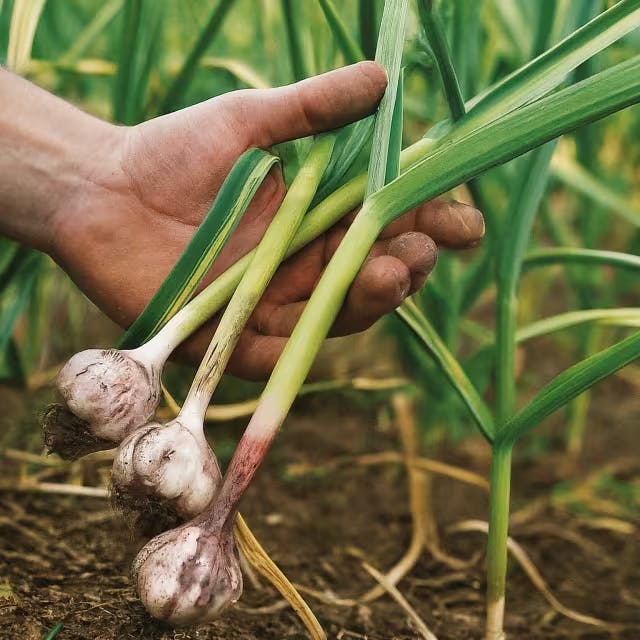
Garlic rust, a formidable foe for garlic growers, first made its presence known in Minnesota in July 2010, sparking concerns over the safety of the U.S. garlic industry. This incident, caused by the fungal pathogen Puccinia allii, echoes the challenges faced by California's garlic production in the 1990s, underlining the importance of proactive measures in combatting garlic rust: prevention and treatment. This article aims to arm gardeners and agriculturalists with knowledge and strategies for combating garlic rust, from understanding its causes and symptoms to exploring effective prevention measures and treatment options, ensuring the protection and prosperity of their garlic crops.
Key Takeaways
Garlic rust, caused by the fungal pathogen Puccinia allii, first affected Minnesota in 2010 and has historical precedence in California during the 1990s, posing a significant threat to the U.S. garlic industry.
Identifying the causes and symptoms of garlic rust is crucial in early detection and effective management of the disease.
Proactive measures, including employing preventive strategies and maintaining garden hygiene, are essential to safeguard garlic crops against rust infestation.
Timely and effective treatment options are available for managing garlic rust, helping to minimize damage and yield loss.
Early identification and addressing garlic rust signs can significantly impact the successful containment and control of the disease.
Implementing proper garden hygiene practices plays a pivotal role in preventing the spread of garlic rust and ensuring the health and productivity of garlic crops.
Understanding Garlic Rust: Causes and Symptoms
Garlic rust, caused by the fungus Puccinia allii, presents a serious threat to garlic crops, capable of reducing both yield and quality. Initially manifesting as small flecks, it evolves into distinctive reddish-orange pustules primarily on the foliage. Without intervention, rust progresses, initially damaging older leaves and potentially decreasing bulb size and quality, which underscores the importance of early detection.
Understanding the environmental requirements of this fungus is key. Puccinia allii favors cool, humid conditions, thriving in such climates which allow it to overwinter on alliums and reemerge. Effective strategies against garlic rust hinge on preemptive actions, such as crop rotation, ensuring adequate space between allium plantings to minimize risk, and eradicating volunteer plants which could harbor the fungus.
For those in regions suitable for garlic cultivation, incorporating preventative measures, as detailed in The Ultimate Guide to Growing Garlic at Home, can significantly mitigate the threat posed by garlic rust. Additionally, fungicide applications may serve as a valuable tool in combatting infection, especially when environmental conditions favor the development of rust.
For further reading on garlic rust and its impact, insights from recent outbreaks provide valuable lessons. A notable instance occurred in Minnesota in 2010, where garlic plants displayed symptoms of rust infection. DNA sequencing confirmed the presence of Puccinia allii, mirroring a strain closely related to one previously identified in California, except for minor genetic variations. While the Minnesota outbreak did not severely impact the 2010 garlic crop, and no subsequent outbreaks occurred, it underscored the necessity of vigilance and the benefit of understanding garlic rust's epidemiology for effective crop protection. More details on this case and its implications can be found in the research published on PubMed and further elaborated upon by UCANR.
By aligning cultivation practices with recommended preventive strategies, gardeners and commercial growers alike can bolster their defense against garlic rust, safeguarding their crops and ensuring bountiful harvests.
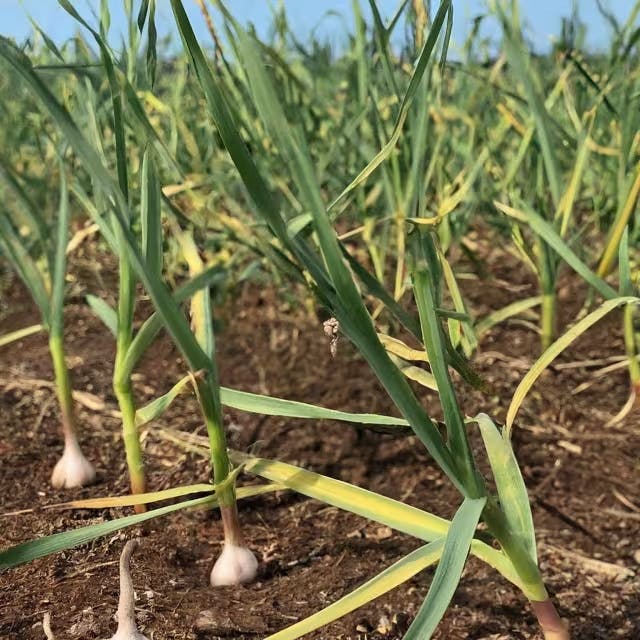
Proactive Measures for Preventing Garlic Rust
Embracing the art of smart gardening can greatly lower the risk of your garlic suffering from rust. The first step is to choose garlic varieties that are resistant to disease, offering a solid defense right from the get-go. Making sure your garlic has plenty of space allows for better airflow, which keeps the plants drier and reduces the chances of rust spores finding a cozy home. Keep a close eye on your plants for any early rust signs and promptly remove any affected leaves to halt the spread. Another vital tactic is crop rotation. Steer clear of planting garlic where any alliums (like onions, garlic, or leeks) have grown in the previous two years. This helps interrupt the life cycle of the rust-causing fungus, diminishing its likelihood of survival. Furthermore, ensuring your soil is well-balanced and healthy can make your plants more resilient to diseases like rust. Adding organic material and making sure your soil drains well can create an environment that's less inviting for rust.
For specific advice on picking the right disease-resistant garlic and employing effective crop rotation, delve into our in-depth guides on gardening techniques and plant health.
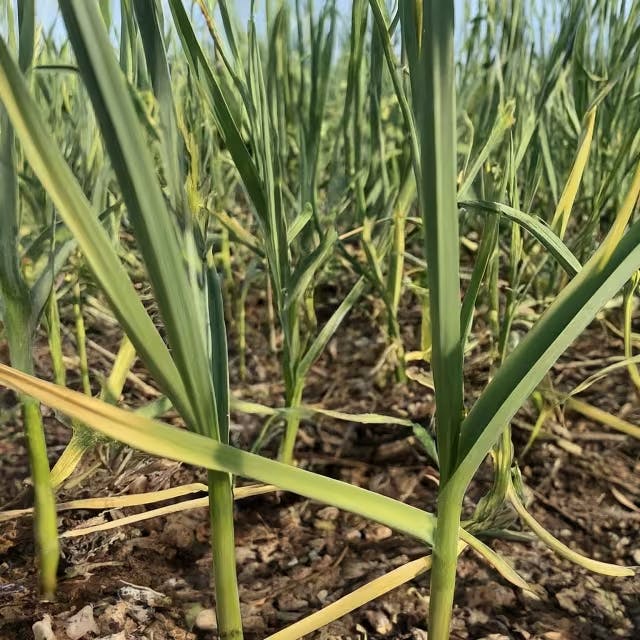
Effective Treatment Options for Garlic Rust Infestation
Dealing with garlic rust requires a proactive approach, blending treatment strategies with a continuous vigil on prevention. First, remove and discard any infected plant parts immediately—this cannot be stressed enough. It helps to prevent the spread of the disease throughout your garden. Remember, do not compost these parts as rust spores can survive and return to haunt your garden.
For chemical treatment options, fungicides containing copper or sulfur can be effective but should be used as a last resort and in accordance with the product's instructions. Additionally, applying neem oil, an organic option, has shown some effectiveness in managing rust by suppressing spore germination. Keep in mind, these treatments are more about managing the disease for the current season rather than completely eradicating it from your garden.
Cultural practices play a vital role in preventing garlic rust. Rotate your garlic and other allium crops every three to four years to avoid the buildup of pathogens in the soil. Aim for well-drained soil and ample spacing between plants to reduce humidity levels, which rust thrives on. Enhancing plant vigor through balanced fertilization—avoiding high nitrogen levels which can exacerbate rust susceptibility—also contributes significantly to your plants' ability to stave off diseases.
Finally, stay informed about the local weather conditions, as a wet, colder spring can escalate rust issues. Tracking and adjusting your gardening practices based on real-time data and weather trends can significantly reduce the impact of garlic rust in your garden.
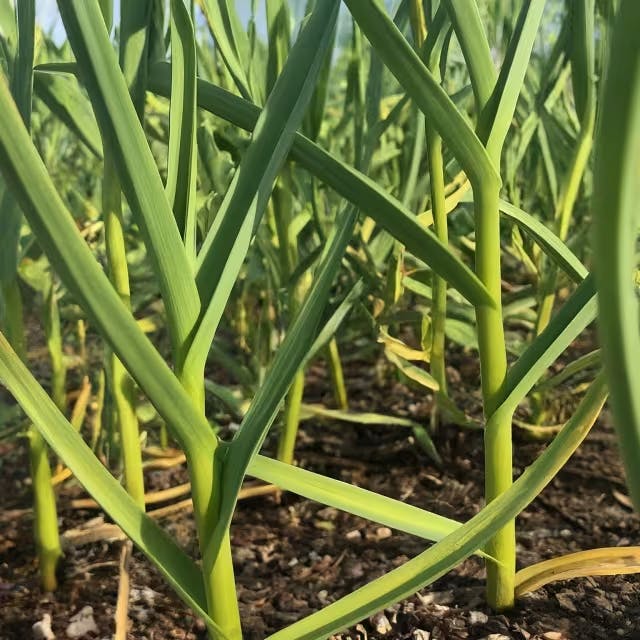
The Role of Proper Garden Hygiene in Combating Garlic Rust
Keeping a clean garden might seem like a bit of gardening wisdom everyone knows, but it’s especially crucial for dodging garlic rust. Making a habit of clearing away dead leaves and plant matter really lessens the likelihood of fungal diseases setting in. Moreover, rotating where you plant garlic each year is smart since it avoids giving any lingering diseases a place to call home.
The health of your soil plays a huge role, too. Using a DIY seed starting and potting mix can give your plants a strong start. This special blend, which includes peat moss, vermiculite, and compost, creates the perfect home for young garlic plants, helping them fight off diseases. If you're curious about how to whip up this mix, check out DIY seed starting and potting mix for gardeners.
Another green thumb tip is to use newspaper pots for your seedlings. They're not just good for the planet; they also reduce the shock of moving plants, which can otherwise make them easy targets for diseases like garlic rust. You can learn how to make your own newspaper pots right here.
By sticking to these garden cleanliness habits and starting strong with the right soil and planting methods, you're setting up your garlic for a healthy, rust-free life.
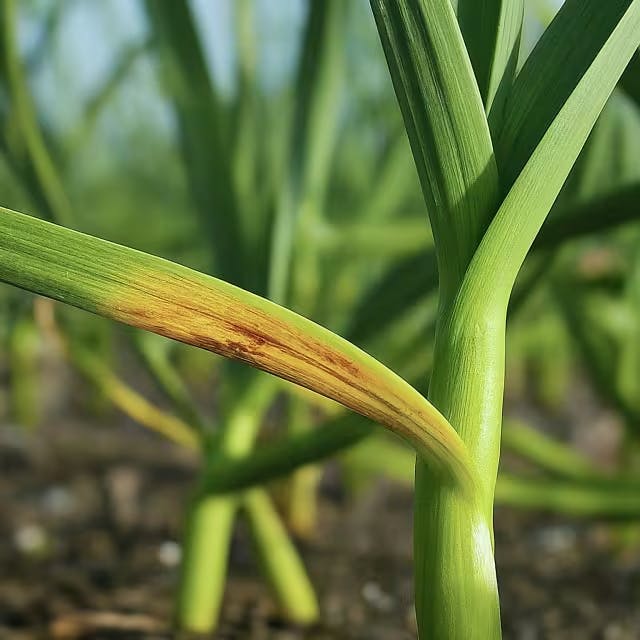
Identifying and Addressing Garlic Rust Early
Recognizing garlic rust early can significantly impact your ability to manage this fungal disease effectively. This condition, characterized by small, orange to brown pustules on leaves, can weaken your plants, diminishing yields. Spotting these symptoms promptly allows for timely intervention.
Upon identification, removing and disposing of affected leaves is crucial to prevent further spread. Ensure to avoid composting these leaves, as this can harbor the fungus. Integrating crop rotation and ensuring proper spacing between plants enhances air circulation, a key factor in minimizing the conditions fungi thrive in.
Here's a brief overview of essential steps in managing garlic rust:
Prevention Tips | Treatment Actions |
1. Crop rotation | 1. Removal of affected leaves |
2. Optimal spacing | 2. Fungicide application (if necessary) |
3. Avoiding overhead watering | 3. Increasing plant vigor through balanced nutrition |
For gardeners aiming to ready their gardens for different seasons, understanding how to transition your garden for fall can also offer insights into implementing seasonal strategies that combat garlic rust. This includes mulching and soil testing, indirectly supporting disease management by enhancing overall plant health.
Implementing these strategies diligently can create a robust defense against garlic rust, ensuring your garlic crops remain healthy and productive. Combating garlic rust effectively requires a comprehensive approach that combines prevention, timely detection, and appropriate treatment strategies. By understanding the conditions that favor the disease and implementing measures such as proper plant spacing, crop rotation, and the use of fungicides, gardeners and farmers can significantly reduce the risk of garlic rust. Through vigilant observation and the adoption of good garden hygiene practices, it is possible to maintain healthy garlic crops and minimize the impact of this persistent plant disease.
Frequently Asked Questions
What are the early signs of garlic rust and how can you intervene quickly?
Recognizing garlic rust early involves spotting small, orange to brown pustules on leaves. Key interventions include promptly removing and disposing of affected leaves (avoid composting), practicing crop rotation, and ensuring proper spacing between plants to enhance air circulation. For severe cases, applying fungicides containing copper or sulfur may be necessary, following the product's instructions closely. Additionally, fostering plant resilience through balanced fertilization and avoiding high nitrogen levels can help in preventing garlic rust.
How does crop rotation help in combatting garlic rust in garlic cultivation?
Crop rotation plays a crucial role in combating garlic rust by disrupting the life cycle of the Puccinia allii fungus, which causes the disease. By avoiding planting garlic or other alliums (such as onions and leeks) in the same location for at least two to three years, the risk of rust persistence and reinfection is significantly reduced. This practice, combined with maintaining proper plant spacing for adequate air circulation and eradicating volunteer plants that may harbor the fungus, effectively lowers the probability of rust outbreaks and supports healthier garlic crops.
Can fungicides effectively manage garlic rust, and what are the alternatives for organic gardens?
Fungicides containing copper or sulfur can be effective in managing garlic rust in non-organic settings. However, for organic gardens, neem oil acts as a natural alternative, suppressing spore germination and aiding in disease management. Additionally, implementing cultural practices such as crop rotation, avoiding overhead watering, ensuring plants have ample space for air circulation, and promptly removing infected plant parts help prevent the spread of garlic rust.
Why is spacing between garlic plants important for preventing rust, and how much space is recommended?
Spacing between garlic plants is pivotal in preventing rust because it ensures better airflow, reducing humidity around the plants. This environment is less favorable for the development of Puccinia allii, the fungus responsible for garlic rust. It is recommended to space garlic plants at least 6 inches apart within rows, with rows being spaced 12 to 18 inches apart. This spacing helps minimize the risk of rust by decreasing the chances of spore transfer between plants and facilitates easier monitoring and management of the crop's health.
How do gardening practices like crop rotation and soil health play into the prevention of garlic rust?
Gardening practices like crop rotation and maintaining soil health are crucial in preventing garlic rust. Rotating garlic and other allium crops prevents pathogen buildup in the soil, while healthy soil supports stronger plant growth, making them less susceptible to diseases. Adequate spacing and ensuring well-drained soil also reduce humidity around plants, discouraging the favorable conditions garlic rust thrives in. Together, these methods form a preventative strategy against this fungal disease, safeguarding crop yield and quality.